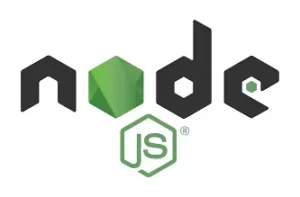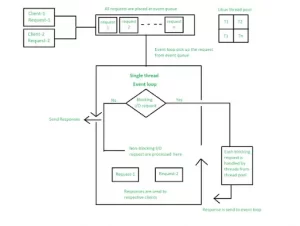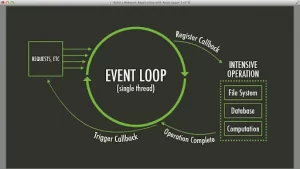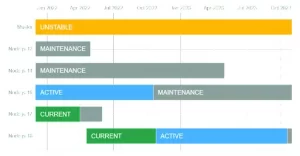Introduction to Node JS Interview Questions And Answers
In Node JS interview questions and answers, it is an open-source and cross-platform JavaScript runtime environment. It is a popular tool for almost any kind of project. Node JS runs the V8 JavaScript engine, the core of Google Chrome, outside of the browser. This allows Node JS to be very performant. A Node JS app runs in a single process, without creating a new thread for every request.
Node JS provides a set of asynchronous Input and Output primitives in its standard library that prevent JavaScript code from blocking and generally, libraries in Node JS are written using non-blocking paradigms, making blocking behavior the exception rather than the norm. Some of the features of Node JS are:
- When Node JS performs an Input/Output operation, like reading from the network, accessing a database or the filesystem, instead of blocking the thread and wasting CPU cycles waiting, Node JS will resume the operations when the response comes back. This allows Node JS to handle thousands of concurrent connections with a single server without introducing the burden of managing thread concurrency, which could be a significant source of bugs.
- Node JS has a unique advantage because millions of frontend developers that write JavaScript for the browser are now able to write the server-side code in addition to the client-side code without the need to learn a completely different language.
- In Node JS the new ECMAScript standards can be used without problems, as you don’t have to wait for all your users to update their browsers – you are in charge of deciding which ECMAScript version to use by changing the Node JS version, and you can also enable specific experimental features by running Node JS with flags.
All these features of Node JS make it highly popular among users. In this article, we will cover all the basic as well as advanced Node JS Interview Questions. If you too want to get the dream job at your organization having detailed knowledge in Node JS will make you a sure shot and every interviewer’s favorite. This article will surely help you delve deep into the basics, intermediate, and advanced levels of Node JS and make you an ace at your next interview.
Node JS Interview Questions For Freshers

In this section of the article we are going to start with the basic Node JS Interview Questions that are generally asked by the interviewers to the freshers.
What Is Node JS?
Node JS is an extremely powerful framework developed on Chrome’s V8 JavaScript engine that compiles the JavaScript directly into the native machine code. It is a lightweight framework used for creating server-side web applications and extends JavaScript API to offer usual server-side functionalities. It is generally used for large-scale application development, especially for video streaming sites, single-page applications, and other web applications. This is one of the important Node JS Interview Questions.

Where can Node JS be used?
Node JS can be used to develop the following applications and systems:
- Real-Time Web Applications
- Network Applications
- Distributed Systems
- General Purpose Applications
This is one of the important Node JS Interview Questions asked to the freshers by the interviewers.
What is the difference between JavaScript and Node JS?
The differences between JavaScript and Node JS are given in the below table:
|
FEATURES |
JAVASCRIPT |
NODE JS |
|
TYPE |
It is a programming language. |
Interpreter and environment for JavaScript. |
|
UTILITY |
Used for any client-side activity for a web application. |
Used for accessing or performing any non-blocking operation of any operating system. |
|
RUNNING ENGINE |
Spider monkey(Firefox), JavaScript Core (Safari), V8 ( Google Chrome), etc. |
V8(Google Chrome) |
This is one of the important Node JS Interview Questions.
How does Node JS work?
Node JS is a virtual machine that uses JavaScript as its scripting language and runs on a v8 environment. It works on a single-threaded event loop and a non-blocking Input and Output which provides a high rate as it can handle a higher number of concurrent requests. Also, by making use of the HTTP Module, Node JS can run on any stand-alone web server in this node JS interview question.
It is a used as backend service where JavaScript works on the server-side of the application. This way JavaScript is used on both the frontend and backend. Node JS runs on chrome v8 engine which converts JavaScript code into machine code, it is highly scalable, lightweight, fast, and data-intensive. This is one of the important Node JS Interview Questions asked to the freshers by the interviewers.

How many types of API functions are there in Node JS?
There are two types of API functions in Node JS:
- Asynchronous, and Non-Blocking Functions- An asynchronous function is any function that delivers its result asynchronously, for example, a callback-based function or a Promise-based function. An asynchronous function is defined via special syntax, involving the keywords async and await. It is also called async/await due to these two keywords.
- Synchronous, Blocking Functions- Synchronous (or sync) execution usually refers to code executing in sequence. In synchronous programming, the program is executed line by line, one line at a time. Each time a function is called, the program execution waits until that function returns before continuing to the next line of code.
This is one of the important Node JS Interview Questions.
What is a package.JS on file in Node JS?
A package.JSon file in Node JS is the heart of the entire application. It is basically the manifest file that contains the metadata of the project where we define the properties of a package. It records important metadata about a project which is required before publishing to NPM and also defines functional attributes of a project that NPM uses to install dependencies, run scripts, and identify the entry point to our package. This is one of the important Node JS Interview Questions asked to the freshers by the interviewers.
What are the benefits of Node JS?
The benefits of using Node JS is a common node JS interview question that lie in its features. The features and the benefit those features provide to the user are given in the following table below:
|
FEATURES OF NODE JS |
BENEFITS/DESCRIPTION |
|
FAST |
JavaScript Engine which makes its library very fast in code execution. |
|
ASYNCHRONOUS |
Node JS is based on the server that never waits for API to return data thus making it asynchronous. |
|
SCALABLE |
It is highly scalable because of its event mech |
|
OPEN-SOURCE |
Node JS has an extensive open-source community that has contributed to producing some excellent modules to add additional capabilities to Node JS applications. |
|
NO BUFFERING |
Node JS applications simply output the data in chunks and never buffer any data. |
This is one of the important Node JS Interview Questions.
Why Node JS is a single-threaded language?
Node JS uses a single-threaded model in order to support async processing. With async processing, an application can perform better and is more scalable under web loads. Thus, in this Node JS interview question it makes use of a single-threaded model approach rather than a typical thread-based implementation. Node JS Platform doesn’t follow the Multi-Threaded Request/Response Stateless Model. It follows the Single-Threaded with Event Loop Model.
Node JS Processing model mainly inspired by JavaScript Event-based model with JavaScript callback mechanism. Because of this Node JS can handle more concurrent client requests with ease. This is one of the important Node JS Interview Questions asked to the freshers by the interviewers.
What are the differences between Angular and Node JS?
The differences between Angular and Node JS are given in the below table:
|
ANGULAR |
NODE JS |
|
1. It is an open-source web application development framework. |
It is a cross-platform run-time environment for applications. |
|
2. It is written in TypeScript. |
It is written in C, C++, and JavaScript languages. |
|
3. It is used for building single-page client-side web applications. |
It is used for building fast and scalable server-side networking applications. |
|
4. Angular itself is a web application framework. |
Node JS has many different frameworks like Sails.JS,Partial.JS and Express. JS,etc. |
|
5. It is ideal for creating highly active and interactive web applications. |
It is ideal for developing small-size projects. |
|
6. It is helpful in splitting an app into MVC components. |
It is helpful in generating database queries. |
|
7. It is suitable for developing real-time applications. |
It is suitable in situations where something faster and more scalable is required. |
This is one of the important Node JS Interview Questions.
What is an Event loop in Node JS and how does it work?
An event loop in Node JS interview questions it handles all the asynchronous callbacks in an application. It is one of the most important aspects of Node JS and the reason behind Node JS has non-blocking Input and Output. Since Node JS is an event-driven language, you can easily attach a listener to an event, and then when the event occurs the callback will be executed by the specific listener.
Whenever functions like setTimeout, HTTP.get, and fs.readFile are called, Node JS executed the event loop and then proceeds with the further code without waiting for the output. Once the entire operation is finished, Node JS receives the output and then executes the callback function. This is why all the callback functions are placed in a queue in a loop. Once the response is received, they are executed one by one. This is one of the important Node JS Interview Questions asked to the freshers by the interviewers.

Node JS Interview Questions For Intermediate Level

In this section of the Node JS interview questions article, we are going to start with some Node JS Interview Questions that are generally asked by the interviewers to the intermediate-level employees or early career professionals.
Which environment is Node JS bundled in?
Node JS comes bundled with a REPL environment by default.REPL in Node JS stands for Read, Eval, Print, and Loop. It represents a computer environment such as a window console or Unix/Linux shell where any command can be entered and then the system can respond with an output. REPL can perform the below-listed tasks:
- Read: Reads the user’s input, parses it into JavaScript data structure, and then stores it in the memory.
- Eval: Receives and evaluates the data structure.
- Print: Prints the final result.
- Loop: Loops the provided command until CTRL+C is pressed twice.
This is one of the important Node JS Interview Questions asked to the intermediate-level employees by the interviewers.
What is an error-first callback in Node JS?
Error-first callbacks in Node JS interview questions are used to pass errors and data. The very first parameter you need to pass to these functions has to be an error object while the other parameters represent the associated data. Thus you can pass the error object for checking if anything is wrong and handle it. In case there is no issue, you can just go ahead with the subsequent arguments. This is one of the important Node JS Interview Questions asked to the intermediate-level employees by the interviewers.
What is the use of the module.exports in Node JS?
A module in Node JS interview questions are used to encapsulate all the related codes into a single unit of code which can be interpreted by shifting all related functions into a single file. Module exports are the instructions that tell Node JS which bits of code (functions, objects, strings, etc.) to export from a given file so that other files are allowed to access the exported code.
The main purpose of the module.exports is to achieve modular programming. Modular programming refers to separating the functionality of a program into independent, interchangeable modules, such that each contains everything necessary to execute only one aspect of the desired functionality. This is one of the important Node JS Interview Questions.
What do you understand about the Reactor Pattern in Node JS?
Reactor Pattern in Node JS is basically a concept of non-blocking Input and Output operations. This pattern provides a handler that is associated with each input/Output operation and as soon as an Input/Output request is generated, it is then submitted to a demultiplexer. This demultiplexer is a notification interface that is capable of handling concurrency in non-blocking Input/Output mode. It also helps in collecting each and every request in the form of an event and then placing each event in a queue.
Thus resulting in the generation of the Event Queue. Simultaneously, we have our event loop which iterates the events present in the Event Queue. This is one of the important Node JS Interview Questions asked to the intermediate-level employees by the interviewers.
What are LTS releases of Node JS?
LTS stands for Long Term Support version of Node JS that receives all the critical bug fixes along with security updates and performance improvements. These versions are supported for at least 18 months and mainly focus on stability and security. The modifications done to the LTS versions are restricted to bug fixes, security upgrades, npm, documentation updates, performance improvement, etc. This is often asked to the candidate in their Node JS in
terview Questions.
LTS release status is “long-term support”, which typically guarantees that critical bugs will be fixed for a total of 30 months. Production applications should only use Active LTS or Maintenance LTS releases. This is one of the important Node JS Interview Questions asked to the intermediate-level employees by the interviewers.

What are the security implementations within Node JS?
Major security implementations in Node JS are
- Authentications-Authentication is the process of verifying a user’s identification through the acquisition of credentials and using those credentials to confirm the user’s identity. The authorization process begins if the credentials are legitimate. The authorization process always follows the authentication procedure.
- Error Handling-Errors in Node JS is handled through exceptions. An exception is created using the ‘throw’ keyword. As soon as JavaScript executes this line, the normal program flow is halted and the control is held back to the nearest exception handler.
This is one of the important Node JS Interview Questions asked to the intermediate-level employees by the interviewers.
What is libuv in Node JS?
Libuv is a multi-platform support library of NODE JS which majorly is used for asynchronous Input and Output. It was primarily developed for Node JS, with time it is popularly practiced with other systems like Luvit, pyuv, Julia, etc. Libuv is basically an abstraction around libev/ IOCP depending on the platform, providing users an API based on libev. A few of the important features of libuv are:
- Full-featured event loop backed.
- File system events.
- Asynchronous file & file system operations.
- Asynchronous TCP & UDP sockets.
- Child processes.
This is one of the important Node JS Interview Questions.
What is the concept of middleware in Node JS?
In general, middleware is a function that receives the Request and Response objects. In other words, in an application’s request-response cycle these functions have access to various request & response objects along with the next function of the cycle. The next function of middleware is represented with the help of a variable, usually named next. The most commonly performed tasks by the middleware functions are:
- Execute any type of code.
- Update or modify the request and the response objects.
- Finish the request-response cycle.
- Invoke the next middleware in the stack.
This is one of the important Node JS Interview Questions asked to the intermediate-level employees by the interviewers.
What is the concept of the URL Module of Node JS?
The URL module of Node JS provides various utilities for URL resolution and parsing. It is a built-in module that helps in splitting up the web address into a readable form. To include the URL module, the user has to use the require() method. Parse an address with the url.parse() method, and it will return a URL object with each part of the address as properties.
This is one of the important Node JS Interview Questions asked to the intermediate-level employees by the interviewers.
How does the Control Flow Function work in Node JS?
In Node JS, the control flow function is basically the code that is executed between the asynchronous function calls. Below are the steps that must be followed for executing it:
- Firstly, the order of execution must be controlled.
- Then, the required data need to be collected.
- Next, the concurrency must be limited.
- Once done, the next step of the program has to be invoked.
This is one of the important Node JS Interview Questions asked to the intermediate-level employees by the interviewers.
Node JS Interview Questions For Advanced Level

In this section of the article, we are going to start with the advanced level Node JS Interview Questions that are generally asked by the interviewers.
What is the difference between spawn() and fork() methods in Node JS?
The difference between spawn() and fork() methods in Node JS is given in the table below:
|
SPWAN() METHOD IN NODE JS |
FORK() METHOD IN NODE JS |
|
In Node JS, the spawn() is used to launch a new process with the provided set of commands. This method doesn’t create a new V8 instance and just one copy of the node module is active on the processor. When your child process returns a large amount of data to the Node you can invoke this method. |
Whereas, the fork() in Node JS is a special instance of spawn() that executes a new instance of the V8 engine. This method simply means that multiple workers are running on a single Node code base for various tasks. |
|
SYNTAX: child_process.spawn(command[,args][,options]) |
SYNTAX: child_process.fork(modulePath[,args][,options]) |
This is one of the important Node JS Interview Questions.
What are global objects in Node JS?
In Node JS, Globals are the objects which are global in nature and are available in all the modules of the application. You can use these objects directly in your application, rather than having to include them explicitly. The global objects can be modules, functions, strings, objects, etc. Moreover, some of these objects can be in the module scope instead of the global scope. Global Objects are built-in objects that are part of JavaScript and can be used directly in the application without importing any particular module. This is one of the important Node JS Interview Questions.
What is the concept of stub in Node JS?
In Node JS, stubs are basically the programs or functions that are used for stimulating the module or component behavior. During any test cases, stubs provide the canned answers to the functions.
Features of stub:
- Stubs can be anonymous.
- Stubs can be wrapped into existing functions. When we wrap a stub into the existing function the original function is not called.
- Stubs are functions or programs that affect the behavior of components or modules.
- Stubs are dummy objects for testing.
- Stubs implement a pre-programmed response.
This is one of the important Node JS Interview Questions.
How does assert work in Node JS?
In Node JS, assert is used to write tests. It only provides feedback only when any of the running test cases fails. This module gives you a set of assertion tests which are then used for testing invariants. It is basically used internally by Node JS but using require(‘assert’) code, it can be used in other applications as well. The assert() method tests if a given expression is true
or not. If the expression evaluates to 0, or false, an assertion failure is being caused, and the program is terminated. The assert() method is an alias of the assert. ok() method. This is one of the important Node JS Interview Questions.
REFERENCE IMAGE
What is ExpressJS Package in Node JS?
Express.JS is a framework built on top of Node JS that facilitates the management of the flow of data between servers and routes in server-side applications. It is a lightweight and flexible framework that provides a wide range of features required for the web as well as mobile application development.
Express.JS is developed on the middleware module of Node JS called connect. The connect module further makes use of the HTTP module to communicate with Node JS. Thus, if you are working with any of the connect-based middleware modules, then you can easily integrate with Express.JS.
This is one of the important Node JS Interview Questions.
What is the difference between process.nextTick() and setImmediate()?
In Node JS, process.nextTick() and setImmediate(), both are functions of the Timers module which help in executing the code after a predefined period of time. But these functions differ in their execution which is provided in the table below:
|
PROCESS.nextTICK() |
SETIMMEDIATE() |
|
The process.nextTick function waits for the execution of action till the next pass around in the event loop or once the event loop is completed only then it will invoke the callback function. |
SetImmediate() is used to execute a call-back method on the next cycle of the event loop which eventually returns it to the event loop in order to execute the input/output operations. |
|
The process.nextTICK() is used to schedule a callback function to be invoked in the next iteration of the Event Loop. |
The setImmediate() method is used to execute a function right after the current event loop finishes. |
This is one of the important Node JS Interview Questions.
What is the usage of a buffer class in Node JS?
Buffer class in Node JS is used for storing the raw data in a similar manner to an array of integers. But it corresponds to a raw memory allocation that is located outside the V8 heap. It is a global class that is easily accessible and can be accessed in an application without importing a buffer module. Buffer class is used because pure JavaScript is not compatible with binary data. So, when dealing with TCP streams or the file system, it’s necessary to handle octet streams.
Each buffer corresponds to some raw memory allocated outside V8. Buffers act somewhat like arrays of integers, but aren’t resizable and have a whole bunch of methods specifically for binary data. This is one of the important Node JS Interview Questions.
How does Node JS handle the child threads?
In general, Node JS interview questions it is a single-threaded process and doesn’t expose child threads or thread management methods. But you can still make use of the child threads using spawn() for some specific asynchronous I/O tasks which execute in the background and don’t usually execute any JS code or hinder the main event loop in the application. If you still want to use the threading concept in your application you have to include a module called ChildProcess explicitly. This is one of the important Node JS Interview Questions.
What are a stream in Node JS and its types?
Streams in Node JS interview questions are the collection of data similar to arrays and strings. They are objects using which you can read data from a source or write data to a destination in a continuous manner. It might not be available at once and need not fit in the memory. These streams are especially useful for reading and processing a large set of data. In Node JS, there are four fundamental types of streams:
- Readable: Used for reading large chunks of data from the source.
- Writeable: Use for writing large chunks of data to the destination.
- Duplex: Used for both the functions; read and write.
- Transform: It is a duplex stream that is used for modifying the data.
This is one of the important Node JS Interview Questions.
What is the difference between readFile and createReadStream in Node JS?
Here in this Node JS interview questions provides two ways to read and execute files which are using readFile and CreateStream.The difference between readFile and createReadStream is given in the table below:
|
readFile |
CreateReadStream |
|
readFile() is a fully buffered process that returns the response only when the complete file is pushed into a buffer and is read. |
CreateReadStream is a partially buffered process that treats the entire process as an event series. The entire file is split into chunks which are then processed and sent back as a response one by one. Once done, they are finally removed from the buffer. |
|
It is a memory-intensive process and in the case of large files, the processing can be very slow. |
CreateReadStream is really effective for the processing of large files. |
This is one of the important Node JS Interview Questions.
Conclusion
The popularity of Node JS here in the Node JS interview questions, the JavaScript runtime environment, has been steadily growing since its first release in 2009, and it seems that this trend is here to stay. Node JS is a low-level platform. Node JS is a cross-platform runtime environment, built on V8, a high-performance open-source JavaScript engine.
To ensure outstanding performance, Node JS applies an event-driven, non-blocking I/O paradigm. In order to make things easy and exciting for developers, thousands of libraries were built upon Node JS by the community. Many of those established over time as popular options. One very convenient way to install Node JS is through a package manager. In this case, every operating system has its own.
A solid understanding of Node JS interview questions can make your interviews exciting. We are certain that most of your concerns about Node JS interview questions have been addressed through this insightful blog. We have gathered a wide range of Node JS interview questions that are frequently asked in the interviews.
Frequently Asked Question’s
The main idea of Node JS interview questions: use non-blocking, event-driven I/O to remain lightweight and efficient in the face of data-intensive real-time applications that run across distributed devices.
Node JS operates on a single thread, using non-blocking I/O calls, allowing it to support tens of thousands of concurrent connections held in the event loop. Where Node really shines is in building fast, scalable network applications, as it’s capable of handling a huge number of simultaneous connections with high throughput, which equates to high scalability.
2. Is Node JS frontend or backend?
Node JS can be used both on the front end and the backend. Node JS is an easy choice for developers since both the frontend and backend can be managed with JavaScript as a single language.
Strong backend— Node JS is written in C and C++, which makes it speedy and adds features like networking support. One of the reasons Node JS frameworks are a popular choice for developers building a flexible and scalable backend is their event-driven, non-blocking nature.
3. Is Node JS a programming language?
In Node JS interview questions it is not a programming language. Rather, it’s a runtime environment that’s used to run JavaScript outside the browser. Neither is Node JS a framework (a platform for developing software applications). The Node JS runtime is built on top of a programming language—in this case, JavaScript—and helps in running frameworks themselves. To sum up, Node JS is neither a programming language nor a framework; it’s an environment for them.
4. What is the difference between JavaScript and Node JS?
Node JS is a cross-platform and open-source JavaScript runtime environment that allows the JavaScript to be run on the server-side. Node JS allows JavaScript code to run outside the browser. Node JS comes with a lot of modules and is mostly used in web development. Whereas, JavaScript is a scripting language. It is mostly abbreviated as JS. It can be said that JavaScript is the updated version of the ECMA script. JavaScript is a high-level programming language that uses the concept of Oops but it is based on prototype inheritance.
No, Node JS is not hard to learn. If you already have a strong programming background and you are familiar with JavaScript, you can learn Node JS in a few days. If you have good development experience but no knowledge of JavaScript (the programming language of Node JS), it may take around 2-6 weeks to learn Node JS.
6. Can I use Node JS instead of PHP?
Yes, you can use Node JS instead of PHP especially if speed is extremely important for your application, e.g. a browser-based multiplayer game or a chat application, Node JS can become a better choice than PHP. Comparing Node JS with PHP, the first is inherently asynchronous, event-driven, and non-blocking, while the second is the asynchronous programming language.
7. Is Node JS good for eCommerce?
In Node JS interview questions it is one of the most powerful platforms that can be used for building eCommerce apps. Many of the top eCommerce platforms are built on Node. Here are some of the companies using Node JS: Netflix, NASA, Trello, PayPal, LinkedIn, Walmart, Uber, Twitter, Yahoo, eBay, and GoDaddy.
8. Is Node JS better than Apache?
Yes, Node JS is way better than Apache as Node JS is five times faster than Apache. The Node JS runtime is designed very well to manage requests which involved IO operation, thanks to its asynchronous model. In fact, Node JS was able to increase the managed requests per second in accordance with the increasing concurrency level.
As many browsers competed to offer users the best performance, JavaScript engines also became considerably better. Major browsers worked hard on finding ways to make JavaScript run quicker and offer better support for it. Hence, Node JS was built at the right place and time. On November 8, 2009, at the inaugural European JSConf, the Node JS project was first demonstrated by Dahl. Node JS is a combination of the V8 JavaScript Chrome engine, a low-level I/O API, and an event loop.
10. What is the future of Node JS?
The future appears to be brilliant for Node JS in the front-end world as it seems like no front-end improvement is possible without Node JS at least for the time being. Different Areas: Node JS web development is not utilized in different territories like embedded, Artificial Intelligence (AI), and Machine Learning (ML).
Node JS came out as very famous when you look at it from the angle of a dedicated Node JS developer. Another way to look at it would be from the non-blocking I/O and the simplicity it adds to the development through the utilization of JavaScript as the common language in both the back end and front end.













